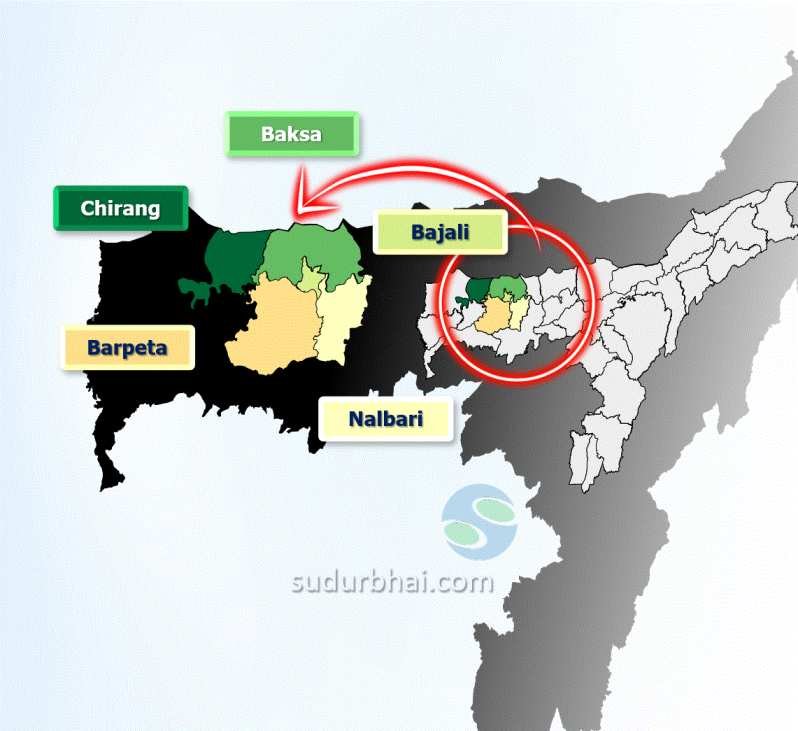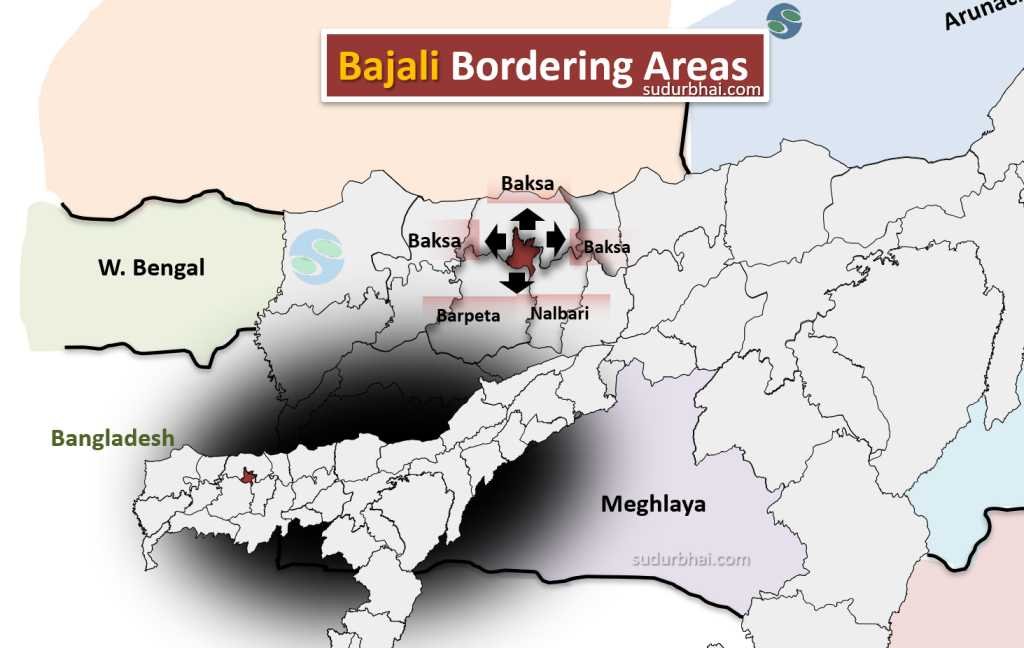Bajali District
INDEX
1. District Overview
2. History of Bajali District
3. Geography of Bajali District
4. Socio-Economy of Bajali District
5. Transport in Bajali District
6. Demographics of Bajali District
7. Administrative Setup of Bajali District
8. Tourist Places in Bajali District
9. Languages Spoken in Bajali District
Overview of Bajali District
- Located in western Assam.
- Newly created district (Notification: Jan 2021 , Briefly revoked : December 2022 , Officially: Oct 2023).
- Formerly a subdivision of Barpeta District.
- District HQ : Pathshala

History of Bajali District
Ancient and Pre-Colonial Period
The region historically known as Bajali has been referenced as Bajali Chakla, Bajali Pargana, Bajali Tehsil, and Bajali Circle at various times.
During the Mughal (Patshahi) rule, Bajali was part of Sarkar Kamrup and administered by local chieftains such as the Pani-Abhaypuria Rajkhowa.
The area’s name is believed to be linked to Bajaliya Konwar, a local ruler, though details about his lineage remain unclear.
In the later Ahom period, parts of Bajali were administered by Bajalia Choudhury, whose origins trace back to Dhawalguru (Purusottam Dwija).
Colonial Era
Under British rule, Bajali underwent significant administrative changes, including the introduction of new land revenue systems and the abolition of the traditional Paik system, which caused hardship for local elites.
Bajali was the site of notable agrarian resistance. In 1869, an agrarian revolt broke out in response to a doubling of land taxes, leading to the organization of Raijmels (people’s assemblies) at places like Gobindapur and Patacharkuchi.
These assemblies protested tax policies and organized collective action, including no-tax campaigns and the appointment of their own messengers and guards to resist British enforcement.
The British authorities responded with arrests and suppression, but the resistance demonstrated the region’s early sense of collective identity and nationalism.
Modern Administrative Changes
Bajali became a civil sub-division of Barpeta district in 1989.
The Assam Cabinet, led by then Chief Minister Sarbananda Sonowal, approved the creation of Bajali as a full-fledged district on 10 August 2020.
Bajali was formally declared Assam’s 34th district on 12 January 2021, carved out from Barpeta.
On 31 December 2022, Bajali was temporarily merged back with Barpeta district as part of a state-wide administrative reorganization linked to the delimitation process.
The Assam government restored Bajali’s district status on 12 October 2023, making it the 35th district of Assam, with its headquarters at Madan Rauta Nagar, Pathsala
Geography of Bajali District
- Area: 422.95 sq km (163.30 sq mi), similar in size to Barbados.
- Rivers: Kaldia, Pahumara, Deojara, and Palla
- Boundaries:
- North: Baksa District
- East: Baksa and Nalbari Districts
- South: Nalbari and Barpeta Districts
- West: Baksa District

Bajali bordering districts
- Terrain: Primarily plains with scattered hills.
- Climate:
- Summer: Excessive humidity.
- Winter: Moderately cold and foggy (November to February).
- Dry period: February to April (moisture levels low).
- Rainfall: May to September ( 2700 mm).
- Pleasant weather: October-November, foggy atmosphere till January.
- Dry and dusty: February-March.
Socio-Economy of Bajali District
- Main Economy: Agriculture (70% of the population dependent).
- Crops: Rice, Wheat, Maize, Jute, Potato, Mustard, Vegetables, Soyabean, Tobacco.
- Fruits : Mango, orange, Jackfruits, Lemon, Arecanut, coconut, Papaya etc.
- Soil & Climate: Favorable for agriculture with sufficient rainfall.
- Forestry: Significant role in economy, providing firewood, timber, bamboo, Ikra, thatch for daily needs and construction.
- Forest Type: Evergreen, with diverse tree species.
Transport in Bajali District
- Road Connectivity:
- NH-31 passes through the district.
- State Highway 127A connects to Bhutan.
- Road linking Bhawanipur to Manas National Park.
- Several arterial roads connect district headquarters to other centers.
- Rail Connectivity:
- Railway stations : Pathsala, Sarupeta and NizSariha.
- Road Connectivity:
Demographics of Bajali District
- Population (2011 Census): 324,739 (similar to Iceland).
- Population Density: 768 people per sq km.
- Growth Rate (2001-2011): 21.43%.
- Sex Ratio: 1002 females per 1000 males.
- Literacy Rate: 88.18%.
- Male : 93.12%
- Female : 83.26%
- Communities:
- Scheduled Castes: 7.56%.
- Scheduled Tribes: 4.52%.
- Religious Composition:
- Hindu: ~68%.
- Muslim: ~32%.
- Other religions: Very few.
- Languages:
- Official: Assamese and English.
- Majority: Assamese.
- Minority: Bodo, Bengali, Marwari, Bihari (microscopic minority).
Administrative Setup of Bajali District
- Revenue Circles: 2 (Bajali, Sarupeta).
- Development Blocks: 2 (Bajali, Bhawanipur).
- Gram Panchayats: 33.
- Villages: 212.
- Police Stations: 2.
- Municipal Boards: 2 (Pathsala, Patacharkuchi).
- Geographical Area: 422.95 sq km.
- Population: 395,000 (approx.).
- Literacy Rate: 71.03% (Male: 75.72%, Female: 64.04%).
- Major Rivers: 2 (Kaldia, Pahumara).
- Communication: Bus, Railway, and Airways.
Attractive tourist places:
- Jalikhata (popularly known as Kalibari Than) -This serene spot features one of the oldest living banyan trees in India and a revered Shiva temple
- Parihareswar Devalaya (Dubi Devalaya) – An ancient Shiva temple built by Ahom King Siva Singha, known for its historical significance, unique Devadasi dance tradition
- Gopal Ata Than (Bhabanipur Satra) – Founded by Gopal Ata, a prominent disciple in the Vaishnavite tradition, this Satra is known for its role in spreading the teachings of Neo-Vaishnavism.
- Bamakhata Satra – A significant Vaishnavite monastery, Bamakhata Satra is a center for Assamese culture and spirituality.
- Bhogeswar Mandir, Uzan Ulua – Set amidst lush grasslands by the Kaldia River, this temple offers a peaceful environment for worship and reflection, making it a favorite among pilgrims and those seeking natural beauty.
- Pahumara Chapori – This scenic river island on the Pahumara River is ideal for picnics and nature walks.
- Akaya Satra – Established around 1500 by the revered saint Sankardev, it is one of the oldest Satras in the region and holds significant cultural and religious importance.
Language spoken in Bajali :
The primary languages spoken in Bajali include:
- Assamese: 74.5%
- Bengali: 20.8%
- Boro: 4.3%
- Other minority languages: 0.36%
Let us know any further suggestions ,we at sudurbhai.com will be happy to hear from you in our comment section below !
